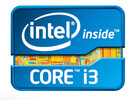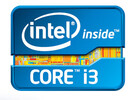Intel Core i3-3130M vs Intel Core i3-3229Y vs Intel Core i3-3110M
Intel Core i3-3130M
► remove from comparison
The Intel Core i3-3130M is a dual-core processor for laptops based on the Ivy Bridge architecture. Due to Hyperthreading, the two cores can handle up to four threads in parallel leading to better utilization of the CPU. Each core offers a base speed of 2.6 GHz, Turbo Boost is not supported. As its Sandy-Bridge-based predecessors, it offers a 3 MB L3-Cache.
Ivy Bridge is an enhanced die shrink of the Sandy Bridge architecture with improvements on both GPU and CPU performance. The CPUs are produced in 22nm (versus 32nm Sandy Bridge CPUs) and are the first to introduce 3D transistors for increased energy efficiency when compared to similarly clocked Sandy Bridge processors. Other new features are integrated PCI Express 3.0 and DDR3(L)-1600 support.
The performance of the Core i3-3130M is slightly above a similarly clocked Sandy Bridge processor due to slight architectural improvements. As a result, overall performance should be about 10-15 % faster compared to the old i3-2370M. Thanks to their Turbo Boost, Core-i5-models like the i5-3210M are significantly faster.
The integrated Intel HD Graphics 4000 offers 16 Execution Units (EUs) clocked at 650 MHz up to 1100 MHz with Turbo Boost. Therefore, the performance should be similar to the AMD Radeon HD 6620G.
Just like most other Ivy Bridge dual-cores, the i3-3130M is rated at a TDP of 35 W. Therefore, even smaller laptops can use the Core i3.
Intel Core i3-3229Y
► remove from comparisonThe Intel Core i3-3229Y is an ULV-processor for ultrabooks and tablets based on the Ivy Bridge architecture. Due to Hyperthreading, the two cores can handle up to four threads in parallel leading to better utilization of the CPU. Each core offers a clock speed of 1.4 GHz (no Turbo Boost). As other dual core Core i3, the 3229Y offers a 3 MB L3 cache.
Ivy Bridge is an enhanced die shrink of the Sandy Bridge architecture with improvements on both GPU and CPU performance. The CPUs are produced in 22nm (versus 32 nm Sandy Bridge CPUs) and are the first to introduce 3D transistors for increased energy efficiency when compared to similarly clocked Sandy Bridge processors. The Core i3 is compatible with dual-channel DDR3L-1600 or DDR3-1600 RAM but, unlike some of the Core i5 and Core i7 Ivy Bridge family CPUs, does not support PCI-Express 3.0.
The integrated Intel HD Graphics 4000 features 16 Execution Units (EUs) clocked at 350 MHz up to 850 MHz with Turbo Boost, delivering a performance comparable with an AMD Radeon HD 6520G.
Performance
The average 3229Y in our database matches the Core i3-2357M, a substantially more power-hungry chip of the previous generation, in multi-thread performance, highlighting the progress Intel has managed to make gen-to-gen. The Core i3 is capable of handling most day-to-day tasks without major slowdowns, as of late 2021.
Your mileage may vary depending on how competent the cooling solution of your system is.
Power consumption
This little Core i3 series chip has a default TDP of 13 W which it is very likely to abide by, considering there is no Turbo Boost support here. Either way, an active cooling solution will be required to dissipate the heat.
The i3-3229Y is made with one of the very old 22 nm Intel processes for very, very low, as of 2022, energy efficiency.
Intel Core i3-3110M
► remove from comparison
The Intel Core i3-3110M is a dual-core processor for laptops based on the Ivy Bridge architecture. Due to Hyperthreading, the two cores can handle up to four threads in parallel leading to better utilization of the CPU. Each core offers a base speed of 2.4 GHz, Turbo Boost is not supported. As its Sandy-Bridge-based predecessors, it offers a 3 MB L3-Cache.
Ivy Bridge is an enhanced die shrink of the Sandy Bridge architecture with improvements on both GPU and CPU performance. The CPUs are produced in 22nm (versus 32nm Sandy Bridge CPUs) and are the first to introduce 3D transistors for increased energy efficiency when compared to similarly clocked Sandy Bridge processors. Other new features are integrated PCI Express 3.0 and DDR3(L)-1600 support.
The performance of the Core i3-3110M is slightly above a similarly clocked Sandy Bridge processor due to the architectural improvements. As a result, overall performance is about 5 % faster compared to the old i3-2370M. Thanks to their Turbo Boost, Core-i5-models like the i5-3210M are significantly faster (10 - 30 %).
The integrated Intel HD Graphics 4000 offers 16 Execution Units (EUs) clocked at 650 MHz up to 1000 MHz with Turbo Boost. Therefore, the performance is slightly below an AMD Radeon HD 6620G.
Just like most other Ivy Bridge dual-cores, the i3-3110M is rated at a TDP of 35 W. Therefore, even smaller laptops can use the Core i3.
| Model | Intel Core i3-3130M | Intel Core i3-3229Y | Intel Core i3-3110M | ||||||||||||||||||||||||||||||||||||||||
| Series | Intel Core i3 | Intel Core i3 | Intel Core i3 | ||||||||||||||||||||||||||||||||||||||||
| Codename | Ivy Bridge | Ivy Bridge-Y | Ivy Bridge | ||||||||||||||||||||||||||||||||||||||||
| Series: Core i3 Ivy Bridge |
|
| |||||||||||||||||||||||||||||||||||||||||
| Clock | 2600 MHz | 1400 MHz | 2400 MHz | ||||||||||||||||||||||||||||||||||||||||
| L1 Cache | 128 KB | 128 KB | 128 KB | ||||||||||||||||||||||||||||||||||||||||
| L2 Cache | 512 KB | 512 KB | 512 KB | ||||||||||||||||||||||||||||||||||||||||
| L3 Cache | 3 MB | 3 MB | 3 MB | ||||||||||||||||||||||||||||||||||||||||
| Cores / Threads | 2 / 4 | 2 / 4 | 2 / 4 | ||||||||||||||||||||||||||||||||||||||||
| TDP | 35 Watt | 13 Watt | 35 Watt | ||||||||||||||||||||||||||||||||||||||||
| Technology | 22 nm | 22 nm | 22 nm | ||||||||||||||||||||||||||||||||||||||||
| max. Temp. | 90 °C | 105 °C | 90 (PGA), 105 (BGA) °C | ||||||||||||||||||||||||||||||||||||||||
| Socket | FCBGA1023, FCPGA988 | BGA1023 | FCBGA1023, FCPGA988 | ||||||||||||||||||||||||||||||||||||||||
| Features | HD Graphics 4000 (650-1100MHz), DDR3-1600 Memory Controller, HyperThreading, AVX, Quick Sync, Virtualization | DDR3-1600/DDR3L-1600 RAM, PCIe 2, 5 GT/s bus, MMX, SSE, SSE2, SSE3, SSSE3, SSE4.1, SSE4.2, AVX | HD Graphics 4000 (650-1000MHz), DDR3-1600 Memory Controller, HyperThreading, AVX, Quick Sync, Virtualization VT-x | ||||||||||||||||||||||||||||||||||||||||
| iGPU | Intel HD Graphics 4000 (650 - 1100 MHz) | Intel HD Graphics 4000 (350 - 850 MHz) | Intel HD Graphics 4000 (650 - 1000 MHz) | ||||||||||||||||||||||||||||||||||||||||
| Architecture | x86 | x86 | x86 | ||||||||||||||||||||||||||||||||||||||||
| $225 U.S. | $250 U.S. | $225 U.S. | |||||||||||||||||||||||||||||||||||||||||
| Announced | |||||||||||||||||||||||||||||||||||||||||||
| Manufacturer | ark.intel.com | ark.intel.com | ark.intel.com |


 Deutsch
Deutsch English
English Español
Español Français
Français Italiano
Italiano Nederlands
Nederlands Polski
Polski Português
Português Русский
Русский Türkçe
Türkçe Svenska
Svenska Chinese
Chinese Magyar
Magyar
